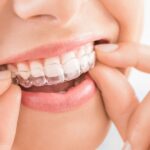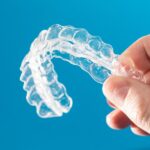Invisalign London, (also known as clear aligners), provides a popular orthodontic treatment option that is designed to straighten teeth without the use of traditional metal braces.
These aligners are made of a clear, plastic material that is custom-fitted to your teeth, and they work by gradually moving your teeth into their desired positions over time.
In this article, how clear aligners work will be explored, their efficacy, and whether they may be a good choice for you.

How do clear aligners work?
Clear aligners work by applying gentle, consistent pressure to your teeth to gradually move them into their desired positions.
To create your aligners, your orthodontist will first take impressions of your teeth to create a digital model of your mouth. This model will be used to design a treatment plan that outlines the movement of your teeth during treatment.
The aligners are then custom-made based on this treatment plan, with each aligner representing a different stage of the tooth movement.
You will need to wear each aligner for a certain amount of time before moving on to the next one in the series, as prescribed by your orthodontist.
The efficiency of clear aligners
The efficiency of clear aligners depends on several factors, such as the severity of your orthodontic issues and your commitment to wearing the aligners as prescribed by your orthodontist.
In general, clear aligners are good at straightening mild to moderate orthodontic issues, such as crowding or gaps in the teeth. However, they may not be as efficient at treating more complex orthodontic problems, such as severe overbites or underbites.
It is important to note that clear aligners only work if they are worn as prescribed by your orthodontist. This typically means wearing them for at least 20-22 hours per day, only removing them for eating, drinking, brushing, and flossing.
If the aligners are not worn consistently, they will not be able to move your teeth into their desired positions. Overall, the efficacy of clear aligners can vary depending on the individual and their specific orthodontic needs.
Related Posts
Pros and cons of using clear aligners
There are both pros and cons to using clear aligners as an orthodontic treatment option. One potential benefit of clear aligners is their discreet appearance.
Clear aligners are virtually invisible, so they are a good option for people who want to straighten their teeth without the noticeable appearance of metal braces.
They are convenient. Clear aligners can be removed for eating, drinking, brushing, and flossing, making them a more lifestyle-friendly option than traditional braces.
Also, clear aligners are made of a smooth, plastic material that is gentle on the teeth and gums, so they are generally considered to be more comfortable than metal braces.
However, there are also some potential drawbacks to using clear aligners, such as if you are not willing to commit to wearing the aligners consistently, they may not be as good at straightening your teeth.
Clear aligners may not be so beneficial for treating more severe orthodontic issues, such as severe overbites or underbites. In these cases, alternative orthodontic treatment options may be better.




